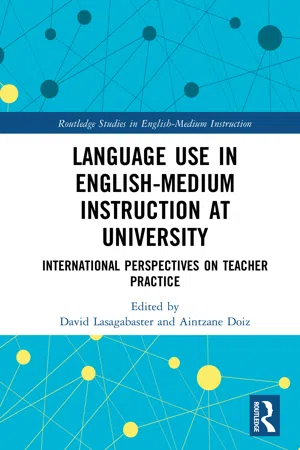
Language Use in English-Medium Instruction at University
International Perspectives on Teacher Practice
- 222 pages
- English
- ePUB (mobile friendly)
- Available on iOS & Android
Language Use in English-Medium Instruction at University
International Perspectives on Teacher Practice
About This Book
This collection brings together insights from research and scholars' practical experience on the role of language and language use in teacher practices at the university level in EMI contexts, offering global perspectives across diverse educational settings.
The volume considers the language-related practices, processes and ways of thinking implemented in EMI contexts as teachers and students co-construct meaning through interaction while also situating these observations within the wider educational policies of institutions, societal norms and contextual pedagogies. The book highlights both the diversity and commonalities of the challenges and opportunities in enhancing student experience in different EMI contexts, drawing on international perspectives spanning South America, Europe and Asia. In so doing, the volume offers a comprehensive portrait of the current realities of the EMI experience at the university level, empowering stakeholders to critically reflect upon and adapt their classroom strategies to their own realities and chart new directions for research in the field.
The book will be of particular interest to scholars interested in issues in English-medium instruction, applied linguistics, language policy and language education, as well as those currently teaching in EMI contexts.
Frequently asked questions
Information
1An Exploratory Analysis of Language Related Episodes (LREs) in a Brazilian EMI Context
Lecturers’ and Students’ Perspectives
Introduction
Table of contents
- Cover
- Half Title
- Series Page
- Title Page
- Copyright Page
- Table of Contents
- List of Contributors
- Introduction: Foregrounding Language Issues in English-Medium Instruction Courses
- Chapter 1: An Exploratory Analysis of Language Related Episodes (LREs) in a Brazilian EMI Context: Lecturers’ and Students’ Perspectives
- Chapter 2: Analysing EMI Teachers’ and Students’ Talk about Language and Language Use
- Chapter 3: EMI Teachers’ Use of Interactive Metadiscourse in Lecture Organisation and Knowledge Construction
- Chapter 4: Strategies to Enhance Comprehension in EMI Lectures: Examples from the Italian Context
- Chapter 5: EMI Materials in Online Initial English Language Teacher Education
- Chapter 6: Pronunciation in EMI: A Preliminary Study of Spanish University Students’ Intelligibility and Comprehensibility
- Chapter 7: Students’ Language-Related Challenges of Studying through English: What EMI Teachers Can Do
- Chapter 8: Challenges of English-Medium Higher Education: The First-Year Experience in Hong Kong Revisited a Decade Later
- Chapter 9: Implementing EMI in Higher Education: Language Use, Language Research and Professional Development
- Chapter 10: Epilogue: Disciplinary Literacies as a Nexus for Content and Language Teacher Practice